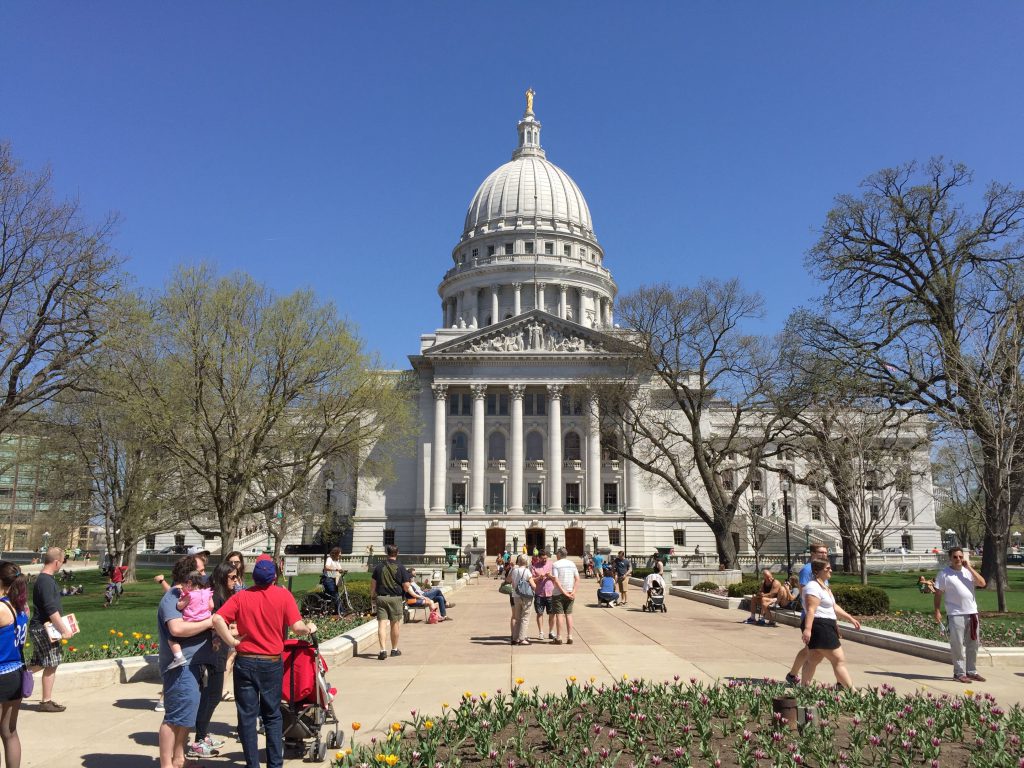State Trails Nation on Women Legislators
Wisconsin in decline since 2003, far fewer women candidates and winners than neighboring states.
November 6, 2018 marked an historic election in the United States due to the unprecedented numbers of women elected to state and national offices. Iowa, Maine and South Dakota elected their first women governors, Arizona, Mississippi and Tennessee elected their first women senators, and 37 new women were elected to the U.S. House of Representatives. These historic results, however, were not equally distributed between the two major political parties.
Of the 37 women newly elected to the House in 2018, 35 were Democrats. Out of the 102 women overall in the House, 89 are Democrats compared to 13 Republicans, a nearly sevenfold difference. As for the U.S. Senate, one-quarter of the upper chamber of Congress is made up of women, 17 of whom are Democrats compared to eight Republicans. At the state level, the number of women serving in many legislatures mirror national trends, though some states, like Wisconsin, lag behind these levels.
A WisContext investigation of how this phenomenon played out in the 2018 midterms within Wisconsin illustrated how these elections yielded far fewer women candidates — and winners — for state-level elections compared to neighboring states. Data provided by the Wisconsin Women’s Council show representation in the state legislature has not exceeded a high of 37 total women in the Assembly and state Senate, previously reached in 1989 and 2003. The 2019-20 class of legislators in Wisconsin has only 29 women serving in office, out of a total 132 seats in both chambers.
As is the case with national trends, women in the Wisconsin Legislature are more likely to be Democrats. Since 2001, the percentage of Democrats who are women in the Assembly and Senate has seen a steady increase, with 2019 marking the first year over 50 percent of Democrats elected to the Assembly are women. On the other hand, women state senators who are Republicans comprised nearly 47 percent of all GOP state senators in 2001, dropping to less than 11 percent almost two decades later.
The 2010 midterm elections marked a noteworthy juncture in Wisconsin politics. Riding the tea party wave, Wisconsin Republicans achieved significant victories, and took control of both legislative houses and the governorship. By 2012, the Republicans majority redrew state legislative districts through the decennial redistricting process, with the resulting maps providing them electoral advantages compared to Democratic candidates.
The gendered election results for both Republican and Democratic Legislature candidates highlight this shift. When comparing elections before and after 2010, state legislative districts after redistricting were more electorally stable, with incumbents having a stronger advantage. The post-2010 districts affected participation by Republican women candidates, while at the same time increased stability for Democrats (both men and women).
Election results offer brief snapshots of political trends and only highlight part of the broader story. While it is clear that women are more active running and winning elections running as Democrats, it still does little to illuminate other component of the election system that affect participation by gender.
Men remain more likely to run for office at the state level in Wisconsin compared to women. But is there something that is preventing more women from becoming candidates? And why are they less likely to get elected when they do run? The requirements for elected legislators offer one potential reason for these disparities.
Wisconsin’s Assembly and Senate can be classified as a full-time or a professional Legislature, meaning members are required to be available throughout the calendar year. This requirement places obvious limitations for participation for a vast number of employed individuals.
The U.S. Bureau of Labor Statistics indicates that women outnumber men in certain professional jobs, like teaching and nursing, and are often the primary caregivers for dependents. For these reasons, professionals like teachers, nurses, doctors, bankers and so on are unable to leave their jobs to participate in state government because of their career requirements, leaving the self-employed (such as business owners, lawyers and farmers) more opportunity to combine both their current employment and the responsibilities of an elected position.
The National Conference of State Legislatures categorizes the Michigan Legislature as full-time, well paid and with a large staff. Both Illinois and Wisconsin’s legislatures are identified as full-time “lite,” with those in Iowa and Minnesota considered a hybrid of full and part-time. Michigan legislators make in excess of $71,000 plus expenses, Illinois $67,000 plus a per diem, with Wisconsin legislators nearly $51,000 with a per diem. Iowa officials earn $25,000 plus a per diem, but only meet between January and the first week of May, with Minnesota following a similar schedule and paying legislators $31,000 plus a per diem.
It’s clear differences exist between all five of the states as to participation by women in politics. Salaries and/or fewer required days at the statehouse can be one factor driving lower participation by women in Wisconsin politics. The effects of partisan gerrymandering are likewise meaningful. No matter the reasons, though, when it comes to the number women serving in the Wisconsin Legislature, little has changed for a generation.
As Number Of Wisconsin’s Women Legislators Stalls, Partisan Mix Shifts was originally published on WisContext which produced the article in a partnership between Wisconsin Public Radio, Wisconsin Public Television and Cooperative Extension.




















